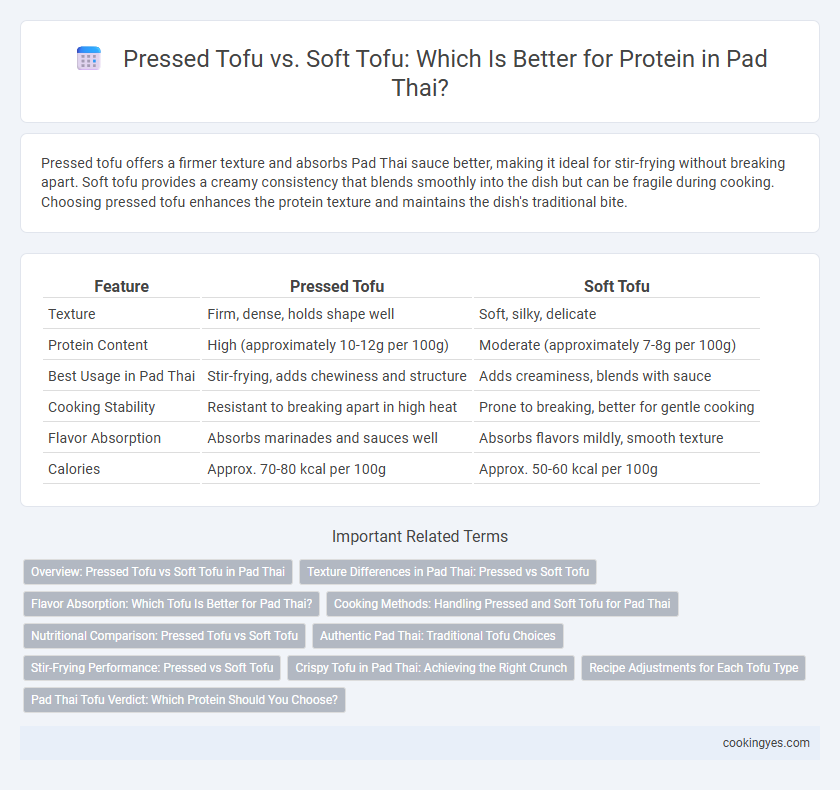Pressed tofu offers a firmer texture and absorbs Pad Thai sauce better, making it ideal for stir-frying without breaking apart. Soft tofu provides a creamy consistency that blends smoothly into the dish but can be fragile during cooking. Choosing pressed tofu enhances the protein texture and maintains the dish's traditional bite.
Table of Comparison
| Feature | Pressed Tofu | Soft Tofu |
|---|---|---|
| Texture | Firm, dense, holds shape well | Soft, silky, delicate |
| Protein Content | High (approximately 10-12g per 100g) | Moderate (approximately 7-8g per 100g) |
| Best Usage in Pad Thai | Stir-frying, adds chewiness and structure | Adds creaminess, blends with sauce |
| Cooking Stability | Resistant to breaking apart in high heat | Prone to breaking, better for gentle cooking |
| Flavor Absorption | Absorbs marinades and sauces well | Absorbs flavors mildly, smooth texture |
| Calories | Approx. 70-80 kcal per 100g | Approx. 50-60 kcal per 100g |
Overview: Pressed Tofu vs Soft Tofu in Pad Thai
Pressed tofu offers a firm texture that holds up well when stir-fried in Pad Thai, providing a chewy protein contrast to the noodles and vegetables. Soft tofu, in contrast, delivers a delicate, creamy texture that absorbs the Pad Thai sauce but can break apart easily during cooking. Choosing pressed tofu enhances the dish's structural integrity, while soft tofu creates a smoother, more tender protein experience.
Texture Differences in Pad Thai: Pressed vs Soft Tofu
Pressed tofu offers a firm, dense texture that holds its shape well when stir-fried in Pad Thai, providing a satisfying chew that complements the dish's noodles and crunchy peanuts. Soft tofu, in contrast, has a delicate, silky texture that can break apart easily, blending smoothly into the sauce but lacking the structural integrity needed for traditional Pad Thai. Choosing pressed tofu enhances the overall textural balance by maintaining distinct protein bites amid the classic Pad Thai ingredients.
Flavor Absorption: Which Tofu Is Better for Pad Thai?
Pressed tofu is ideal for Pad Thai due to its firmer texture and superior flavor absorption, allowing it to soak up the dish's tangy tamarind sauce and spices more effectively than soft tofu. Soft tofu's delicate consistency tends to break apart easily and absorbs less marinade, resulting in a milder flavor profile. Therefore, pressed tofu enhances the authentic savory taste and texture of Pad Thai protein.
Cooking Methods: Handling Pressed and Soft Tofu for Pad Thai
Pressed tofu offers a firm texture that holds up well during stir-frying in Pad Thai, preventing it from crumbling and allowing it to absorb sauces effectively. Soft tofu requires gentler handling and is typically added towards the end of cooking to maintain its delicate structure and creamy consistency. Choosing the appropriate tofu type and cooking method enhances the protein's texture and integration into the classic Pad Thai dish.
Nutritional Comparison: Pressed Tofu vs Soft Tofu
Pressed tofu contains higher protein content and lower water levels compared to soft tofu, making it a denser source of nutrition ideal for Pad Thai. It offers more iron and calcium per serving, supporting muscle function and bone health, while soft tofu contains higher moisture and fewer calories. Choosing pressed tofu enhances the dish's texture and boosts its overall protein value, aligning with nutritional goals.
Authentic Pad Thai: Traditional Tofu Choices
Pressed tofu is the authentic choice for traditional Pad Thai, offering a firm texture that absorbs the sauce without falling apart during cooking. Soft tofu, while common in other dishes, lacks the structure needed to withstand stir-frying and dilutes the dish's signature balance of flavors. Using pressed tofu ensures an ideal protein component that complements Pad Thai's bold, savory taste.
Stir-Frying Performance: Pressed vs Soft Tofu
Pressed tofu offers a firmer texture and retains shape better during stir-frying in Pad Thai, providing a slightly crispy exterior and chewy bite that complements the dish's flavors and prevents sogginess. Soft tofu, while delicate and smooth, tends to break apart easily in high-heat stir-frying, resulting in a creamier consistency but less structural integrity. For optimal protein inclusion in Pad Thai, pressed tofu is preferred due to its superior stir-frying performance and ability to absorb sauces without disintegrating.
Crispy Tofu in Pad Thai: Achieving the Right Crunch
Pressed tofu is ideal for Pad Thai protein due to its firm texture and ability to achieve the perfect crispy exterior when pan-fried, contrasting with soft tofu that tends to crumble and absorb excess moisture. Achieving the right crunch in Pad Thai depends on pressing to remove water, then cooking tofu over medium-high heat until golden brown. This method enhances the tofu's texture, providing a satisfying bite that complements the stir-fried noodles and tangy tamarind sauce.
Recipe Adjustments for Each Tofu Type
Pressed tofu offers a firm texture that holds up well in Pad Thai, allowing for easy stir-frying without crumbling, while soft tofu requires gentle handling and is best added towards the end to prevent breaking apart. Recipe adjustments include marinating pressed tofu to enhance flavor absorption and cutting it into small cubes or strips for even cooking, whereas soft tofu benefits from a lighter marinade and careful folding into the dish to maintain its delicate consistency. Using pressed tofu provides a chewy protein contrast, whereas soft tofu contributes a creamy texture that blends seamlessly with the Pad Thai sauce.
Pad Thai Tofu Verdict: Which Protein Should You Choose?
Pressed tofu offers a firmer texture that holds well during stir-frying, making it ideal for authentic Pad Thai, while soft tofu provides a creamier consistency that absorbs flavors but may break apart easily. Nutritionally, pressed tofu contains higher protein content per serving, enhancing the dish's protein profile. For a balanced Pad Thai with robust texture and maximum protein, pressed tofu is the preferred choice.
Pressed tofu vs soft tofu for Pad Thai protein Infographic

 cookingyes.com
cookingyes.com